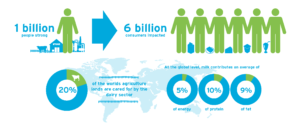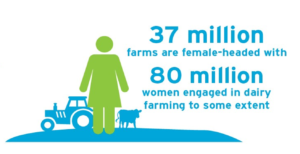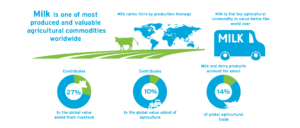NMPF’s Senior Vice President of Communications, Alan Bjerga, discusses the challenges of enforcing the new USMCA trade agreement for dairy; also, a discussion of NMPF’s new “Sharing Our Story” effort, highlighting how dairy farmers have faced the challenges of coronavirus, on RFD-TV.
Tag: trade
NMPF’s Castaneda on Dairy’s Canada Concerns
Jaime Castaneda, NMPF Senior Vice President for Policy Strategy and International Trade, discusses concerns about how Canada may be reducing access to its dairy market through its use of tariff-rate quotas (TRQs) on the Adams on Agriculture podcast.
NMPF’s Bjerga on Dairy’s Electoral Power and “Dairy Defined”
NMPF’s Alan Bjerga discusses the relationship between top dairy states and top swing states in the 2020 presidential campaign; plus, a discussion of NMPF’s “Dairy Defined” opinion and podcast series, on RFD-TV.
U.S. Dairy Industry Praises Administration and Congress for Final Passage of USMCA
ARLINGTON, VA – The U.S. Dairy Export Council (USDEC) and National Milk Producers Federation (NMPF) cheered today’s Senate vote paving the way for the President’s signature of the United States-Mexico-Canada Agreement (USMCA).
Looking ahead, USDEC and NMPF urged U.S. officials to carefully monitor Canada and Mexico’s USMCA commitments once the trade deal takes effect to ensure its provisions are enforced accordingly so that the dairy industry is able to reap the full benefits of the agreement negotiated by Ambassador Lighthizer and the negotiating teams at USTR and USDA.
“USMCA makes important strides to break down trade barriers, opening the door to new opportunities and supporting the flow of high-quality American dairy products to two valuable export markets,” said Tom Vilsack, president and CEO of USDEC. “The strong enforcement measures included in the final agreement give officials the tools necessary to hold our trade partners accountable and ensure the gains secured by USMCA are completely realized. We are grateful to the Administration for the sizable accomplishments secured in USMCA on dairy. With this trade deal complete, negotiators can now turn their attention to other key markets around the world in order to gain further ground for U.S. dairy.”
“America’s dairy farmers are celebrating today’s bipartisan vote as a win. Under President Trump’s leadership, USTR and USDA negotiated an agreement that will deliver a more certain future for our dairy farmers and rural economy,” said Jim Mulhern, president and CEO of NMPF. “The U.S. must now remain diligent and proactively work with Canada and Mexico to implement USMCA in both letter and spirit. Full compliance is essential to achieving more fair trade with Canada and protecting American-made cheeses in Mexico.”
USMCA fundamentally changes Canada’s trade-distorting policies, reforms Canada’s controversial dairy pricing system and provides exclusive Canadian market access for U.S. farmers and manufacturers. According to the International Trade Commission, U.S. dairy exports are projected to increase by more than $314 million a year. USMCA also strengthens the relationship between Mexico and the U.S. and establishes new protections for products that rely on common cheese names, such as parmesan and feta.
###
Dairy Defined: Be Thankful for Dairy’s Global Success This Christmas
ARLINGTON, Va. – Despite the seasonal pressures to buy, buy, and buy, the holidays are best as a season for giving. Yes, that means solicitations – deserving charities fill mailboxes, and earnest pleas to remember the less fortunate have become staples of the holiday season.
But for many people in less-wealthy parts of the world, the property for which they can be most thankful is something people in rich nations take for granted: Dairy cows. For all the disparagement it receives in some, more affluent quarters, the fact is that dairy provides livelihoods and nutrition to hundreds of millions of people, many of them poorer, worldwide. Dairy lifts people from poverty and protects them from hunger. Dairy gives women jobs and sends girls to school. Dairy supports ecosystems and connects farmers to markets.
Stepping outside first-world problems for a moment, here for the holidays are a few thoughts on dairy’s global reach, and why we should be thankful for dairy farmers worldwide. (Thank you to Global Dairy Platform, an industry partnership that demonstrates dairy’s contribution to global food systems, healthy diets and sustainable livelihoods, for sharing data and graphics.)
- The world is home to about 133 million dairy farms, with about 600 million people living on those farms. Another 400 million additional people work full-time jobs throughout dairy’s value chain That means more than roughly 1 in 8 people on the planet – 1 billion – are economically supported by dairy.

- Most developing-world dairy farms have herds of two or three cows. Farms with more than 100 cows represent less than 0.3 percent of all dairy farms worldwide.
- Of those 133 million dairy farms, 37 million of them are run by women.

- Milk and dairy products account for about 14 percent of all global agricultural trade.

- Finally, dairy is continually becoming more climate-efficient; greenhouse gas emissions have dropped by 11 percent per unit in the past decade. In North America the declines have been even steeper, falling not just per unit, but in total gross emissions as well.
Dairy is a big deal globally, just as it is in the United States. But dairy looks different in developing countries. It looks more basic, like something that’s essential to simple survival. Like something that should be nurtured and supported as a basic human right.
So when rich-world advocates call for sweeping changes to global diets or eliminating entire agricultural sectors — even though such goals could be met in ways that would allow agriculture to thrive, reduce poverty and contribute to climate and nutrition solutions — keep that in mind. This isn’t only about the 40,000 U.S. dairy farms that are the most carbon-efficient in the world. It’s about 133 million farms and a billion people, many who have much more to worry about than whether their beverage choices signal virtue to their privileged friends.
Let’s be thankful that dairy benefits everyone, regardless of their circumstances or wealth. Let’s work to encourage and sustain its success and celebrate its many contributions to our health and prosperity this Christmas season. Happy holidays, and a happy new year for dairy.
(Note: NMPF’s Dairy Defined explores today’s dairy farms and industry using high-quality data and podcast interviews to explain current dairy issues and dispel myths.)
U.S. Dairy Applauds Japan’s Passage of Trade Deal, Urges Phase Two
ARLINGTON, VA — The U.S. Dairy Export Council (USDEC) and National Milk Producers Federation (NMPF) applaud Japan’s recent passage of Phase One of the U.S.-Japan Trade Agreement and the benefits it will bring the U.S. dairy industry once implemented.
The U.S. dairy industry is now urging U.S. trade negotiators to swiftly complete a Phase Two agreement in order to maximize opportunities for U.S. agriculture — in particular, dairy farmers and processors. It is critical that negotiators consult with Congress during Phase Two negotiations to ensure that the unique needs of various constituencies, including farmers and food manufacturers, are taken into account.
“Trade negotiators made important strides in the Phase One agreement that will serve as a strong foundation for a broader Phase Two agreement, opening the door for U.S. Dairy to fully realize our potential in Japan,” said Tom Vilsack, president and CEO of USDEC. “We know that American-made products can fill the growing Japanese demand for high-quality dairy, but a comprehensive Phase Two agreement is necessary to deliver the complete range of market access opening and assurances necessary to ensure that U.S. dairy products can best compete.”
A 2019 USDEC study found that if the U.S. has at least the same market access as its competitors, the U.S. could roughly double its share of the Japanese market over the next 10 years, underscoring the necessity of a Phase Two agreement. Given the importance of the U.S. market to Japanese exports, NMPF and USDEC have emphasized that the terms of trade offered by Japan to U.S. exports should not just meet but exceed those granted to its less valuable customers.
“We agree with the Administration that market access in Japan under TPP wasn’t sufficient. U.S. negotiators must achieve a better outcome for U.S. dairy farmers in a final agreement to remedy this. Addressing the missing pieces of market access from Phase One and establishing safeguards for the use of common cheese names should be a priority,” said Jim Mulhern, president and CEO of NMPF. “Trade negotiators must finish the job and deliver a full comprehensive agreement that prioritizes the needs of American dairy farmers.”
It is critical that negotiators and policymakers now turn their attention towards finalizing a comprehensive Phase Two agreement that prioritizes dairy access. This includes protecting common cheese names and addressing remaining gaps and inequalities in market access granted to our competitors by the Japan-EU and CPTPP agreements that leave U.S. dairy at a disadvantage.
Dairy Defined Podcast: Mooney Speaks at Annual Meeting
(Note: NMPF’s Dairy Defined podcast explores today’s dairy farms and industry using high-quality data and podcast-style interviews to explain current dairy issues and dispel myths.)
ARLINGTON, Va. – U.S. dairy farmers have been through challenging times, but they’re ready to face the challenges of trade, the environment, climate and changing consumer tastes, said Randy Mooney, a Missouri dairy farmer and chairman of the National Milk Producers Federation. Mooney spoke this morning at the organization’s annual meeting, this in New Orleans.
“Dairy farmers play an important role in society. We help preserve communities,” he said. “Like all of you, I’m proud to be a dairy farmer, producing the most nutritious product in the world.”
To listen to the full podcast, click here. You can also find the Dairy Defined podcast on Spotify and SoundCloud. Broadcast outlets may use the MP3 file. Please attribute information to NMPF.
###
The National Milk Producers Federation (NMPF), based in Arlington, VA, develops and carries out policies that advance dairy producers and the cooperatives they own. NMPF’s member cooperatives produce more than two-thirds of U.S. milk, making NMPF dairy’s voice on Capitol Hill and with government agencies. For more, visit www.nmpf.org.
NMPF’s Morris on EU Dairy Tariffs
NMPF Helps Shape Trade Strategy
The Agricultural Technical Advisory Committees (ATAC) for trade are tasked with providing guidance and technical advice to the USTR and USDA on trade negotiations. NMPF is pleased to share the recent announcement that NMPF’s Jaime Castaneda has been reappointed to the ATAC for Animals and Animal Products, along with John Wilson of Dairy Farmers of America, an NMPF member cooperative.
Castaneda and Wilson will play a valuable role through their continued service on the ATAC and their expertise and first-hand knowledge of the dairy industry will help the USTR and USDA develop effective trade strategies and objectives.
CWT-Assisted Export Sales Contracts Top 9 Million Pounds of Dairy Products
CWT in June assisted member cooperatives in securing 51 contracts to sell 2.888 million pounds of American-type cheeses, 154,324 pounds of anhydrous milkfat, 257,941 pounds of butter, 5.407 million pounds of whole milk powder, and 566,588 pounds of cream cheese. The products will go to customers in Asia, Central America, the Middle East, Oceania and South America. The product will be shipped during the months of June through December 2019, to customers in 14 countries in five regions of the world.
These contracts bring the 2019 total of the CWT-assisted product sales contracts to 30.953 million pounds of cheese, 4.213 million pounds of butter, 35.640 million pounds of whole milk powder, 3.139 million pounds of cream cheese and 154,324 pounds of anhydrous milkfat. These transactions will move the equivalent of 669.376 million pounds of milk on a milkfat basis overseas.
Assisting CWT member cooperatives gain and maintain world market share through the Export Assistance program expands demand for U.S. dairy products and the U.S. farm milk that produces them. This helps all U.S. dairy farmers by strengthening and maintaining the value of dairy products that effect their milk price.
The amounts of dairy products and related milk volumes reflect current contracts for delivery, not completed export volumes. CWT will pay export assistance to the bidders only when export and delivery of the product is verified by the submission of the required documentation.
All cooperatives and dairy farmers are encouraged to add their support to this important program. Membership forms are available at http://www.cwt.coop/membership.
NMPF, Agriculture Groups Work to Keep Science in Scientific Standards
The Codex international food standards are meant to protect human health and establish fair trade practices by developing cohesive food safety standards for food and agricultural products. However, the mandate to base Codex international food standards on scientific fact may be up for debate in July.
The European Union and other countries are seeking to water down Codex’s scientific mandate and instead direct that nonscientific factors, such as consumer preference issues, be considered as Codex develops standards. This would have significant negative repercussions for the American dairy industry and its ability to challenge unscientific barriers to trade.
The Codex Executive Committee and Commission will meet at the beginning of this month to consider revising its procedures in light of EU pressure. NMPF is working with the U.S. Dairy Export Council to lead the charge against these changes and ensure that existing science-based Codex rules are enforced and followed to preserve a level playing field for U.S. exports. The outreach on this issue harnesses a united U.S. food and agricultural effort on this issue, including driving support for U.S positions at the meetings.
NMPF has joined with other leading U.S. agriculture groups to develop materials outlining this threat to share with policymakers and international stakeholders. Together with several of those groups and USDEC, NMPF staff met last month with USDA Undersecretary of Trade Ted McKinney and USTR Chief Agriculture Negotiator Gregg Doud to make the case as to why preserving the scientific structure of Codex is critical.
Dairy Farmers Count on Congress to Pass USMCA
The push to complete the U.S.–Mexico–Canada agreement (USMCA) received a boost in June when Mexico became the first country to ratify the trade agreement. Still, Washington has yet to take action, making collaboration key as NMPF works with other stakeholders to get the agreement over the finish line.
The U.S. Trade Representative’s Office is working with leading members of Congress to hash out a way forward, specifically focusing on concerns expressed by Democrats to guarantee sufficient Congressional support. Complementing that work, about 50 dairy farmers and dairy-cooperative staff took NMPF’s message in support of USMCA’s passage directly to Capitol Hill in June. Their on-the-ground advocacy was dovetailed with NMPF’s work to educate policymakers on the importance of this trade agreement to the dairy industry.
Also last month, NMPF joined forces with the U.S. Dairy Export Council and the International Dairy Foods Association to write to members of Congress from top dairy-producing states, asking them to “please pursue a USMCA vote without delay” on behalf of the dairy farms and businesses they represent.
“Solidifying and expanding trade opportunities abroad through USMCA will improve the prospects of dairy farms here at home,” said Jim Mulhern, president and CEO of NMPF. “In the midst of uncertainty surrounding our trade relationships and yet another year of meager milk prices, the United States lost an average of seven dairy farms a day in 2018. The passage of USMCA will instill a renewed sense of optimism in our dairy farmers.”
USMCA will help bolster the U.S. dairy industry by locking in existing access to our key export market in Mexico while increasing trade opportunities in Canada and establishing new trade rules to discipline Canada’s trade-distorting dairy policies, discourage unscientific barriers to trade and preserve the rights of common cheese name users. U.S. government estimates calculate that USMCA will increase U.S. dairy exports to Mexico and Canada by $277 million once it is fully implemented.





